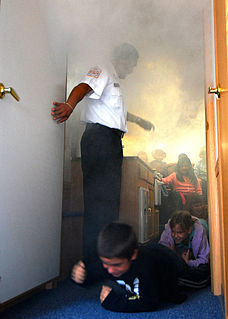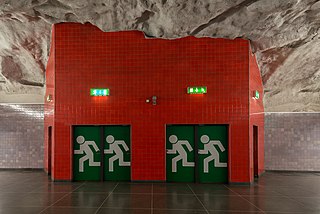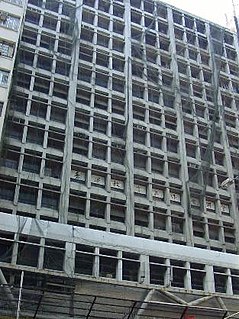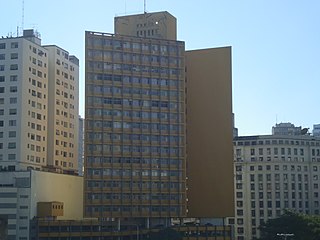Pre-movement time is the time before, and the concomitant events and situational analyses prior to, an evacuation of an area. The term is generally used in referring to large-scale evacuations where the necessity thereof is foreseen. Events that can require pre-movement time include hurricanes, wars, nuclear accidents, and major conflagrations.

Emergency evacuation is the urgent immediate egress or escape of people away from an area that contains an imminent threat, an ongoing threat or a hazard to lives or property.

War is a state of armed conflict between states, governments, societies and informal paramilitary groups, such as mercenaries, insurgents and militias. It is generally characterized by extreme violence, aggression, destruction, and mortality, using regular or irregular military forces. Warfare refers to the common activities and characteristics of types of war, or of wars in general. Total war is warfare that is not restricted to purely legitimate military targets, and can result in massive civilian or other non-combatant suffering and casualties.

A conflagration is a large and destructive fire that threatens human life, animal life, health, and/or property. It may also be described as a blaze or simply a (large) fire. A conflagration can begin accidentally, be naturally caused (wildfire), or intentionally created (arson). Arson can be for fraud, murder, sabotage or diversion, or due to a person's pyromania. A very large fire can produce a firestorm, in which the central column of rising heated air induces strong inward winds, which supply oxygen to the fire. Conflagrations can cause casualties including deaths or injuries from burns, trauma due to collapse of structures and attempts to escape, and smoke inhalation.
Pre-movement time is divided into four distinct events: detection, the recognition of the emergency; decision, to commence evacuation or not, and of how many people and how great a territory; alarm, the announcement of the decision and conveyance to the populace, often by emergency broadcasts or over police loudspeakers, or by actual alarms, such as sirens; and reaction, the events and actions of the people affected, both emergency personnel and the citizenry, immediately after the declaration.[ citation needed ]
Panic is rarely observed during this time, despite media depictions to the contrary. At first, lack of response arising from ignorance of the situation to outright disbelief or denial, is often noted. Different, confusing stimuli (e.g., smells of burning or smoldering, smoke, power outages, or tremors )may be detected and not put together to form a plan to evacuate, thus increasing pre-movement time. If occupants are performing some task or engaging in an activity, they may complete their business before tending to the crisis, even if they had some prior knowledge of it. [1]

Panic is a sudden sensation of fear, which is so strong as to dominate or prevent reason and logical thinking, replacing it with overwhelming feelings of anxiety and frantic agitation consistent with an animalistic fight-or-flight reaction. Panic may occur singularly in individuals or manifest suddenly in large groups as mass panic.

Smoke is a collection of airborne solid and liquid particulates and gases emitted when a material undergoes combustion or pyrolysis, together with the quantity of air that is entrained or otherwise mixed into the mass. It is commonly an unwanted by-product of fires, but may also be used for pest control (fumigation), communication, defensive and offensive capabilities in the military, cooking, or smoking. It is used in rituals where incense, sage, or resin is burned to produce a smell for spiritual purposes. Smoke is sometimes used as a flavoring agent, and preservative for various foodstuffs. Smoke is also a component of internal combustion engine exhaust gas, particularly diesel exhaust.

A power outage is a short-term or a long-term loss of the electric power to a particular area.
As stimuli increase, those affected likely will attempt to ascertain the cause(s); some may walk around their immediate area, look in rooms or offices, and open doors. They may call the custodian or building superintendent to find out the problem. If no response is forthcoming, those affected likely will begin to talk among themselves and figure out the best plan of action. Depending on the information and cues available, this pre-movement time can last from a few seconds to several minutes. [1]
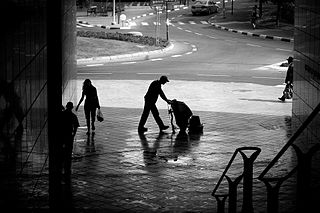
A janitor, janitress (female), custodian, porter, cleaner or caretaker is a person who cleans and maintains buildings such as hospitals, schools, and residential accommodation. Janitors' primary responsibility is as a cleaner. In some cases, they will also carry out maintenance and security duties. A similar position, but usually with more managerial duties and not including cleaning, is occupied by building superintendents in the United States. Cleaning is one of the most commonly outsourced services.
A building superintendent or building supervisor is a term used in the United States and Canada to refer to a manager responsible for repair and maintenance in a residential building. They are the first point of contact for residents of the building.
Part of pre-movement time also involves actions related to saving a structure (especially one's own home or domicile) or personal valuables. Some people will warn others of a danger, especially those close to them like family or dear friends. Evacuees will often contact family members by phone or e-mail to let them know that they are safe and are starting their evacuation. These types of actions are all part of pre-movement time. [1]
Reaction time to an evacuation can vary widely, depending on the type of emergency, its perceived danger, and any false alarms of such an emergency beforehand. It can even be affected by the means of communication. In one study, mock alarms were broadcast to subway riders in London, England using different forms of address: a simple bell, a bell followed by instructions from subway staff, a public address announcement lasting 30 seconds and broadcast twice, a combination of staff instructions and public address, and finally by instructions, public address, informing people of the emergency, and announcing the type of emergency. [2] In most cases, but not always, the more forceful the call to evacuate and the more staff were involved, the quicker riders got on escalators to evacuate. [1]

Rapid transit or mass rapid transit (MRT), also known as heavy rail, metro, subway, tube, U-Bahn or underground, is a type of high-capacity public transport generally found in urban areas. Unlike buses or trams, rapid transit systems are electric railways that operate on an exclusive right-of-way, which cannot be accessed by pedestrians or other vehicles of any sort, and which is often grade separated in tunnels or on elevated railways.
